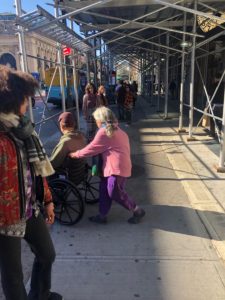Thinkers in Residence spend time on 14th Street over the festival weekend reflecting on 14th Street, patterns of movement, artists, pedestrians, publics, personal reflections, and participation. Their responses take the form of writing, walking, image-making, poetry, or on-the-spot conversations with the public.
And now the observations of Destinee Forbes.
As I made my way downtown the Saturday of the festival, I was looking forward to seeing how each artist chose to interpret the theme of invisibility at this year’s Art in Odd Places festival. The performances I saw that day each broached on the topic of invisibility in subtle ways, however I was most interested in the performances that attempted to make visible gestures of compassion and care.
The first performance I saw was Anna Marie Shogren’s choreographed dance piece Falls. An ensemble of six or so dancers occupied the corner of 14th and 8th Avenue. They swayed uniformly and invited people to participate in their performance. As I arrived, I spoke with Anna briefly about the piece, and she said it was an interactive performance of intergenerational caregiving and wellness. Participants were guided through the piece by dancers. The dancers held the participants hands leading and guiding them through a series of motions.

Each move subtle, with soft caresses leading the individual in and out of seated and standing positions. A dancer’s hand gently guided the participant at all times never leaving contact. The invisibility in the performance rests in the idea of the work of caregiving being an unseen and unnoticed act. In the act of choreographing a didactic performance about the gesture of giving care, Shogren’s performance sheds light on the amount of effort, patience and work that is involved in the process of caring for another, and also, how it can be both an individual and collective task.
Next to Shogren’s performance was Donna Maria de Creeft’s visual and interactive installation Useful Invisibility/ Diatom Prayer. Before I had the chance to introduce myself, de Creeft handed me her phone and asked if I could help her document her performance. I quickly obliged without even knowing what was going to happen. A string of small flags of fractal shapes hung beside her connected to a construction walkway overpass.

As she stood next to these flags, she began giving out small cards for people to take as they walked by her. As she extended these small gifts to the passersby, people quickly ignored her, very rarely accepting what she had to offer. After several minutes of passing out the cards, she paused and I asked her what she was handing out. She handed me a small card that shared the same fractal imagery as the hanging flags. The design was on one side of the card, and on the other the word ‘diatom’ with the sentence, “Diatoms have precise ecological requirements and are used to monitor environmental conditions.” I asked her about the meaning of the sentence and she began explaining that a diatom is a microscopic single-celled alga that is vital to our living but no one really knows about them. She was inspired by not only their beauty, but their purpose and how their work goes unnoticed. They are cells that are literally invisible to the naked eye, and also cells that are overlooked in terms of their function and purpose. As I looked carefully at the card in my hand, she remarked with a laugh, “[and] what could me more invisible than someone handing something out on the street in New York.” I smiled acknowledging and agreeing to her remark. She resumed her position near her flags and began handing out cards one by one. Some would accept and most looked the other way. de Creeft was not asking for anything, but simply sharing knowledge. In extending her hand, she was attempting to connect with others so that they might be able to share that information with someone else.
The task of making visible gestures of kindness, care and compassion requires work in that the participant or viewer must acknowledge and understand the labor and effort of the other. It is an act of not only compassion but empathy as well. It requires the other person to fully understand the emotional effort of the other, and realize that they are giving part of themselves without asking for anything in return. It is an act of acknowledging another’s vulnerability and accepting it without question or judgement.

